Anjali Narayan-Chen
BAP v2: An Enhanced Task Framework for Instruction Following in Minecraft Dialogues
Jan 18, 2025Abstract:Interactive agents capable of understanding and executing instructions in the physical world have long been a central goal in AI research. The Minecraft Collaborative Building Task (MCBT) provides one such setting to work towards this goal (Narayan-Chen, Jayannavar, and Hockenmaier 2019). It is a two-player game in which an Architect (A) instructs a Builder (B) to construct a target structure in a simulated Blocks World Environment. We focus on the challenging Builder Action Prediction (BAP) subtask of predicting correct action sequences in a given multimodal game context with limited training data (Jayannavar, Narayan-Chen, and Hockenmaier 2020). We take a closer look at evaluation and data for the BAP task, discovering key challenges and making significant improvements on both fronts to propose BAP v2, an upgraded version of the task. This will allow future work to make more efficient and meaningful progress on it. It comprises of: (1) an enhanced evaluation benchmark that includes a cleaner test set and fairer, more insightful metrics, and (2) additional synthetic training data generated from novel Minecraft dialogue and target structure simulators emulating the MCBT. We show that the synthetic data can be used to train more performant and robust neural models even with relatively simple training methods. Looking ahead, such data could also be crucial for training more sophisticated, data-hungry deep transformer models and training/fine-tuning increasingly large LLMs. Although modeling is not the primary focus of this work, we also illustrate the impact of our data and training methodologies on a simple LLM- and transformer-based model, thus validating the robustness of our approach, and setting the stage for more advanced architectures and LLMs going forward.
Unsupervised Melody-to-Lyric Generation
May 30, 2023



Abstract:Automatic melody-to-lyric generation is a task in which song lyrics are generated to go with a given melody. It is of significant practical interest and more challenging than unconstrained lyric generation as the music imposes additional constraints onto the lyrics. The training data is limited as most songs are copyrighted, resulting in models that underfit the complicated cross-modal relationship between melody and lyrics. In this work, we propose a method for generating high-quality lyrics without training on any aligned melody-lyric data. Specifically, we design a hierarchical lyric generation framework that first generates a song outline and second the complete lyrics. The framework enables disentanglement of training (based purely on text) from inference (melody-guided text generation) to circumvent the shortage of parallel data. We leverage the segmentation and rhythm alignment between melody and lyrics to compile the given melody into decoding constraints as guidance during inference. The two-step hierarchical design also enables content control via the lyric outline, a much-desired feature for democratizing collaborative song creation. Experimental results show that our model can generate high-quality lyrics that are more on-topic, singable, intelligible, and coherent than strong baselines, for example SongMASS, a SOTA model trained on a parallel dataset, with a 24% relative overall quality improvement based on human ratings. O
Unsupervised Melody-Guided Lyrics Generation
May 26, 2023



Abstract:Automatic song writing is a topic of significant practical interest. However, its research is largely hindered by the lack of training data due to copyright concerns and challenged by its creative nature. Most noticeably, prior works often fall short of modeling the cross-modal correlation between melody and lyrics due to limited parallel data, hence generating lyrics that are less singable. Existing works also lack effective mechanisms for content control, a much desired feature for democratizing song creation for people with limited music background. In this work, we propose to generate pleasantly listenable lyrics without training on melody-lyric aligned data. Instead, we design a hierarchical lyric generation framework that disentangles training (based purely on text) from inference (melody-guided text generation). At inference time, we leverage the crucial alignments between melody and lyrics and compile the given melody into constraints to guide the generation process. Evaluation results show that our model can generate high-quality lyrics that are more singable, intelligible, coherent, and in rhyme than strong baselines including those supervised on parallel data.
Context-Situated Pun Generation
Oct 24, 2022Abstract:Previous work on pun generation commonly begins with a given pun word (a pair of homophones for heterographic pun generation and a polyseme for homographic pun generation) and seeks to generate an appropriate pun. While this may enable efficient pun generation, we believe that a pun is most entertaining if it fits appropriately within a given context, e.g., a given situation or dialogue. In this work, we propose a new task, context-situated pun generation, where a specific context represented by a set of keywords is provided, and the task is to first identify suitable pun words that are appropriate for the context, then generate puns based on the context keywords and the identified pun words. We collect CUP (Context-sitUated Pun), containing 4.5k tuples of context words and pun pairs. Based on the new data and setup, we propose a pipeline system for context-situated pun generation, including a pun word retrieval module that identifies suitable pun words for a given context, and a generation module that generates puns from context keywords and pun words. Human evaluation shows that 69% of our top retrieved pun words can be used to generate context-situated puns, and our generation module yields successful puns 31% of the time given a plausible tuple of context words and pun pair, almost tripling the yield of a state-of-the-art pun generation model. With an end-to-end evaluation, our pipeline system with the top-1 retrieved pun pair for a given context can generate successful puns 40% of the time, better than all other modeling variations but 32% lower than the human success rate. This highlights the difficulty of the task, and encourages more research in this direction.
ExPUNations: Augmenting Puns with Keywords and Explanations
Oct 24, 2022Abstract:The tasks of humor understanding and generation are challenging and subjective even for humans, requiring commonsense and real-world knowledge to master. Puns, in particular, add the challenge of fusing that knowledge with the ability to interpret lexical-semantic ambiguity. In this paper, we present the ExPUNations (ExPUN) dataset, in which we augment an existing dataset of puns with detailed crowdsourced annotations of keywords denoting the most distinctive words that make the text funny, pun explanations describing why the text is funny, and fine-grained funniness ratings. This is the first humor dataset with such extensive and fine-grained annotations specifically for puns. Based on these annotations, we propose two tasks: explanation generation to aid with pun classification and keyword-conditioned pun generation, to challenge the current state-of-the-art natural language understanding and generation models' ability to understand and generate humor. We showcase that the annotated keywords we collect are helpful for generating better novel humorous texts in human evaluation, and that our natural language explanations can be leveraged to improve both the accuracy and robustness of humor classifiers.
Human-guided Collaborative Problem Solving: A Natural Language based Framework
Jul 19, 2022
Abstract:We consider the problem of human-machine collaborative problem solving as a planning task coupled with natural language communication. Our framework consists of three components -- a natural language engine that parses the language utterances to a formal representation and vice-versa, a concept learner that induces generalized concepts for plans based on limited interactions with the user, and an HTN planner that solves the task based on human interaction. We illustrate the ability of this framework to address the key challenges of collaborative problem solving by demonstrating it on a collaborative building task in a Minecraft-based blocksworld domain. The accompanied demo video is available at https://youtu.be/q1pWe4aahF0.
TEACh: Task-driven Embodied Agents that Chat
Oct 15, 2021
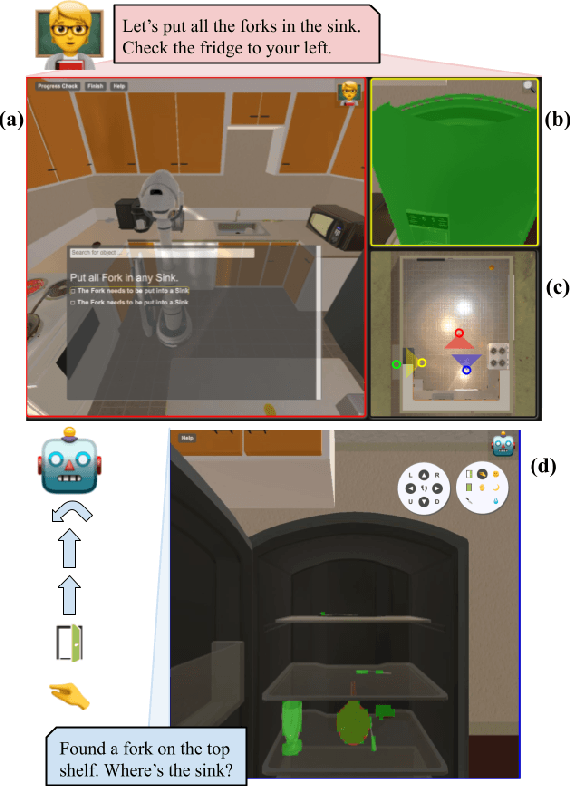

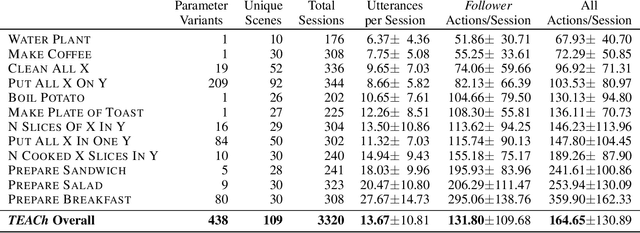
Abstract:Robots operating in human spaces must be able to engage in natural language interaction with people, both understanding and executing instructions, and using conversation to resolve ambiguity and recover from mistakes. To study this, we introduce TEACh, a dataset of over 3,000 human--human, interactive dialogues to complete household tasks in simulation. A Commander with access to oracle information about a task communicates in natural language with a Follower. The Follower navigates through and interacts with the environment to complete tasks varying in complexity from "Make Coffee" to "Prepare Breakfast", asking questions and getting additional information from the Commander. We propose three benchmarks using TEACh to study embodied intelligence challenges, and we evaluate initial models' abilities in dialogue understanding, language grounding, and task execution.
Style Control for Schema-Guided Natural Language Generation
Sep 24, 2021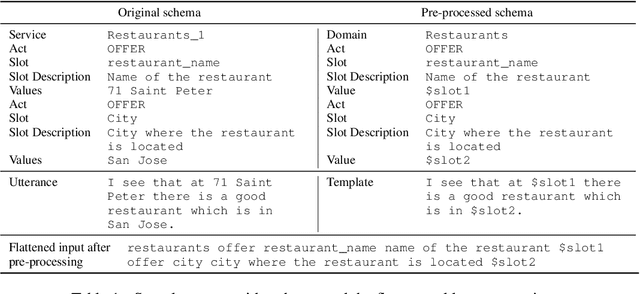
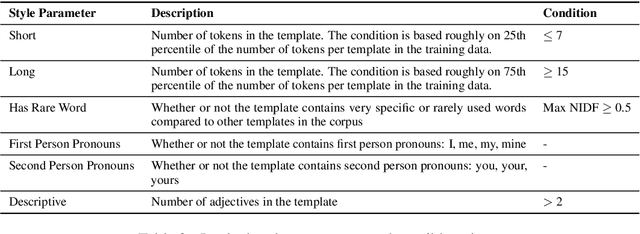
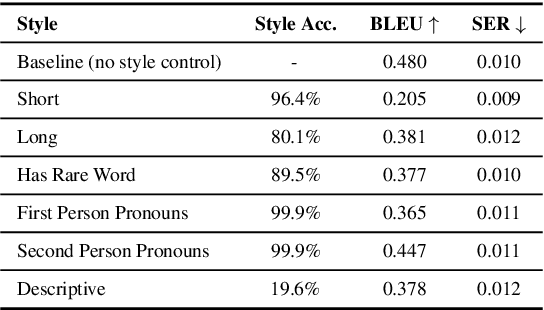

Abstract:Natural Language Generation (NLG) for task-oriented dialogue systems focuses on communicating specific content accurately, fluently, and coherently. While these attributes are crucial for a successful dialogue, it is also desirable to simultaneously accomplish specific stylistic goals, such as response length, point-of-view, descriptiveness, sentiment, formality, and empathy. In this work, we focus on stylistic control and evaluation for schema-guided NLG, with joint goals of achieving both semantic and stylistic control. We experiment in detail with various controlled generation methods for large pretrained language models: specifically, conditional training, guided fine-tuning, and guided decoding. We discuss their advantages and limitations, and evaluate them with a broad range of automatic and human evaluation metrics. Our results show that while high style accuracy and semantic correctness are easier to achieve for more lexically-defined styles with conditional training, stylistic control is also achievable for more semantically complex styles using discriminator-based guided decoding methods. The results also suggest that methods that are more scalable (with less hyper-parameters tuning) and that disentangle content generation and stylistic variations are more effective at achieving semantic correctness and style accuracy.
Schema-Guided Natural Language Generation
May 11, 2020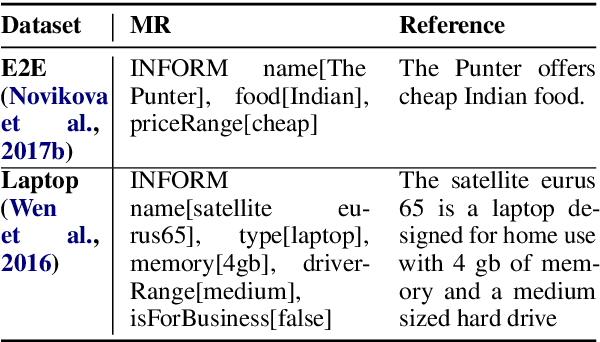

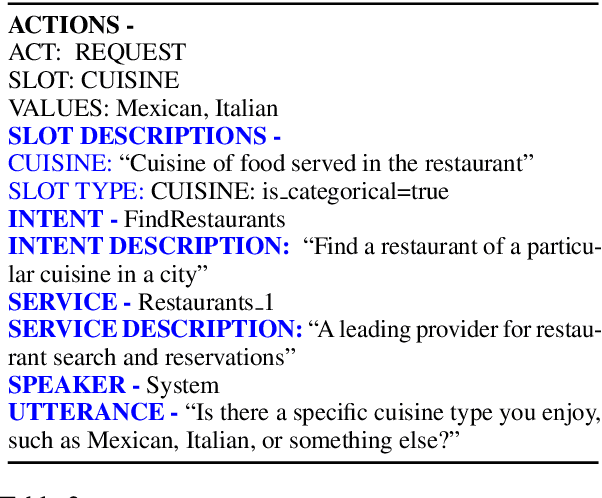
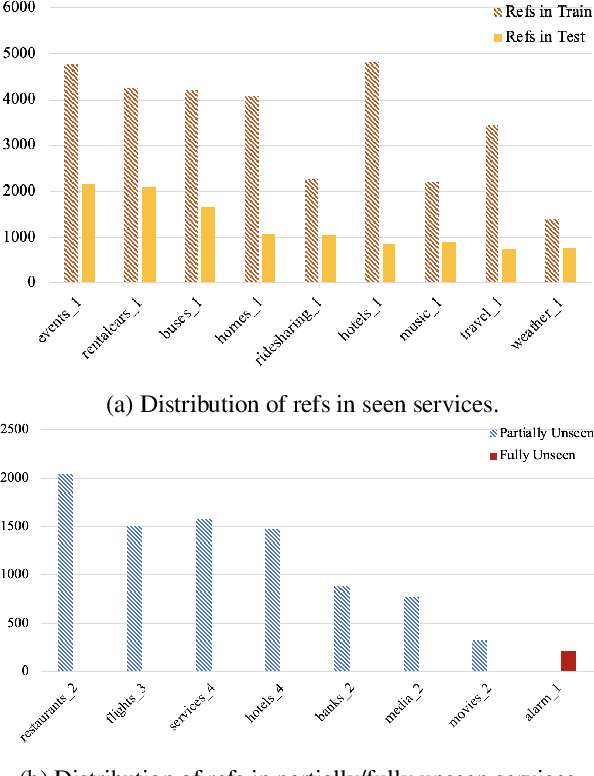
Abstract:Neural network based approaches to natural language generation (NLG) have gained popularity in recent years. The goal of the task is to generate a natural language string to realize an input meaning representation, hence large datasets of paired utterances and their meaning representations are used for training the network. However, dataset creation for language generation is an arduous task, and popular datasets designed for training these generators mostly consist of simple meaning representations composed of slot and value tokens to be realized. These simple meaning representations do not include any contextual information that may be helpful for training an NLG system to generalize, such as domain information and descriptions of slots and values. In this paper, we present the novel task of Schema-Guided Natural Language Generation, in which we repurpose an existing dataset for another task: dialog state tracking. Dialog state tracking data includes a large and rich schema spanning multiple different attributes, including information about the domain, user intent, and slot descriptions. We train different state-of-the-art models for neural natural language generation on this data and show that inclusion of the rich schema allows our models to produce higher quality outputs both in terms of semantics and diversity. We also conduct experiments comparing model performance on seen versus unseen domains. Finally, we present human evaluation results and analysis demonstrating high ratings for overall output quality.
 Add to Chrome
Add to Chrome Add to Firefox
Add to Firefox Add to Edge
Add to Edge